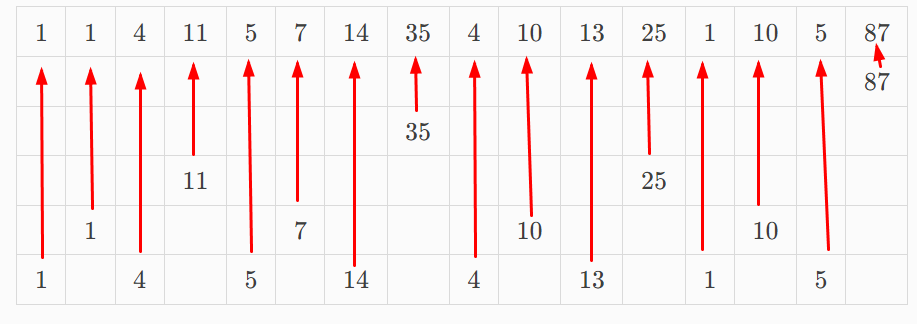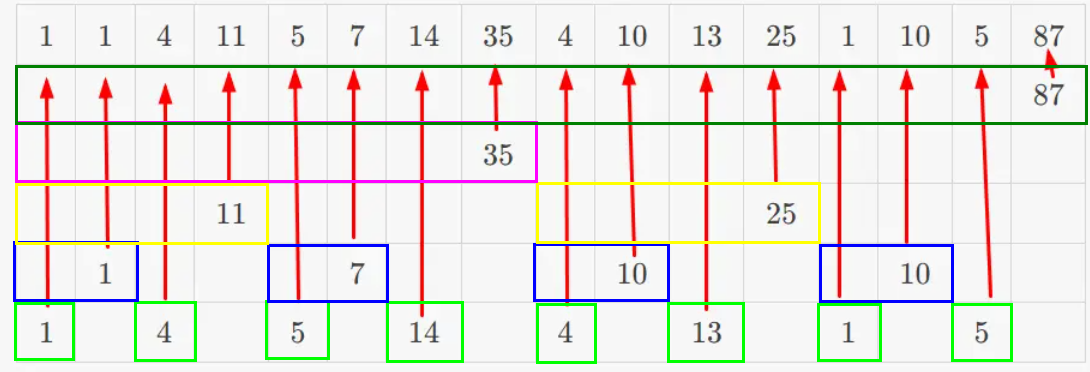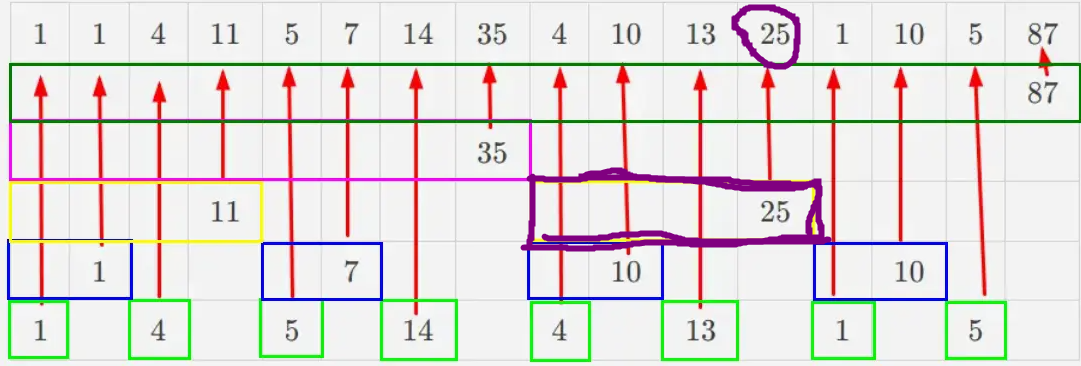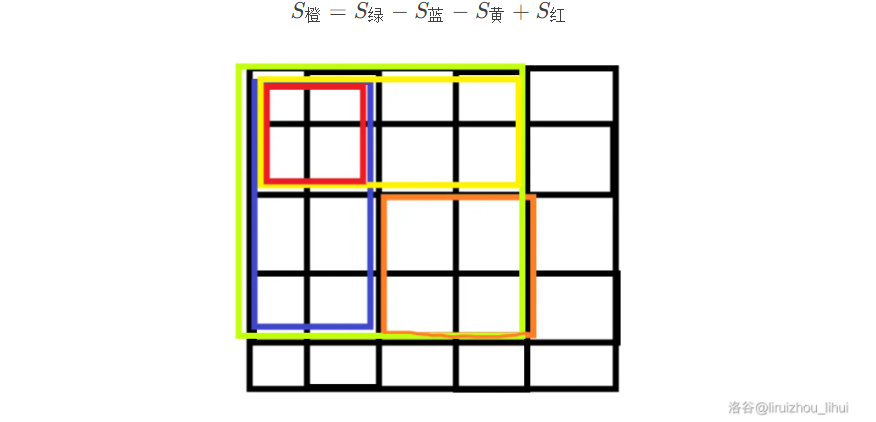主页
搜索
最近更新
数据统计
赞助我们
申请密钥
系统公告
1
/
1
请查看完所有公告
【树状数组】学习笔记
最后更新于 2025-05-01 15:24:59
作者
liruizhou_lihui
分类
算法·理论
复制 Markdown
查看原文
删除文章
更新内容
本文中,为了避免歧义,定义: - $n$:数据数量。 - $a_1 \sim a_n$ 原始数组。 - $b_1 \sim b_n$ 树状数组。 # 引入 给你一个数列 $a_1 \sim a_n$,你需要实现两个函数: - 单点修改:将数列中的一个数值加 $x$。 - 区间查询:求出序列中前几个数的和。 如果用暴力或者前缀和显然是不行的,考虑优化。 # 理论 ## 树状数组的原理 对于这个数列: |$1$|$0$|$4$|$6$|$5$|$2$|$14$|$3$|$4$|$6$|$13$|$2$|$1$|$9$|$5$|$12$| |:-:|:-:|:-:|:-:|:-:|:-:|:-:|:-:|:-:|:-:|:-:|:-:|:-:|:-:|:-:|:-:| 可以把他相邻两个数求和,并归为新的一层,一直这样直到只剩下一个数字。 ||||||||||||||||$87$| |:-:|:-:|:-:|:-:|:-:|:-:|:-:|:-:|:-:|:-:|:-:|:-:|:-:|:-:|:-:|:-:| ||||||||$35$||||||||$52$| ||||$11$||||$24$||||$25$||||$27$| ||$1$||$10$||$7$||$17$||$10$||$15$||$10$||$17$| |$1$|$0$|$4$|$6$|$5$|$2$|$14$|$3$|$4$|$6$|$13$|$2$|$1$|$9$|$5$|$12$| 他们的关系是这样的:  这样就可以用额外计算出的数来优化时间。 到这个时候,求区间的和操作就可以找一些上面的大数,再拿下面的小数凑整。 比如计算前 $13$ 个只需要这些标红数字即可: ||||||||||||||||$87$| |:-:|:-:|:-:|:-:|:-:|:-:|:-:|:-:|:-:|:-:|:-:|:-:|:-:|:-:|:-:|:-:| ||||||||$\color{red}35$||||||||$52$| ||||$11$||||$24$||||$\color{red}25$||||$27$| ||$1$||$10$||$7$||$17$||$10$||$15$||$10$||$17$| |$1$|$0$|$4$|$6$|$5$|$2$|$14$|$3$|$4$|$6$|$13$|$2$|$\color{red}{1}$|$9$|$5$|$12$| 大大优化了运算速度。 这里注意到比如我想求前三个的和,那么第四行第二个数用不到,求前四个和时用第三行第一个更优,所以第四行第二个数没有任何用处。像这样无意义的数据还有很多,每行的第偶数个数据都没用,可以删掉。 ||||||||||||||||$87$| |:-:|:-:|:-:|:-:|:-:|:-:|:-:|:-:|:-:|:-:|:-:|:-:|:-:|:-:|:-:|:-:| ||||||||$35$||||||||| ||||$11$||||||||$25$||||| ||$1$||||$7$||||$10$||||$10$||| |$1$||$4$||$5$||$14$||$4$||$13$||$1$||$5$|| 这时候,每一列恰好都只有一个数,我们把每个数取出来组成一个数组:  |$1$|$1$|$4$|$11$|$5$|$7$|$14$|$35$|$4$|$10$|$13$|$25$|$1$|$10$|$5$|$87$| |:-:|:-:|:-:|:-:|:-:|:-:|:-:|:-:|:-:|:-:|:-:|:-:|:-:|:-:|:-:|:-:| 这个数组就是树状数组,里面的每一个元素都对应着一个区间和。 求和时,只需要找到对应的区间相加求和即可。 修改时,只需要找到向上包含它的区间再修改。 ## $\operatorname{lowbit}$ 函数 $\operatorname{lowbit}(x)$ 可以求出 $x$ 在二进制下最低位代表哪个数字。 比如二进制数字 $10010100100$(十进制 $1188$),它的最低位是 $10010100\color{red}{1}\color{black}{00}$,所代表的数就是 $10010100\color{red}100$。二进制数 $100$ 对应的十进制数就是 $4$,所以$\operatorname{lowbit}(1188)=4$。 代码使用位运算来完成。 ```cpp int lowbit(int x) { return x&(-x); } ``` 证明很简单,自己按位与自己的反码,除了最低有效位其他都会直接抵消。 ## 使用 $\operatorname{lowbit}$ 实现树状数组  观察树状数组,最后一行的序列长度都为 $1$,而这些区间对应的树状数组序号的 $\operatorname{lowbit}$ 也为 $1$。倒数第二行的序列长度为 $2$,他们对应序号的 $\operatorname{lowbit}$ 也为 $2$。 其他的几行也是如此,依次是 $2,4,8,16,\cdots$ 依次是二的整数次幂。 比如 $b_{14}$,它对应的序列长度就是 $\operatorname{lowbit}(14)=4$。其他也是同理。 也就是说,$b_i$ 对应的序列就是长度为 $\operatorname{lowbit}(i)$ 且以 $i$ 结尾的序列。  这个时候,如果我们要求前 $14$ 个数的和,$14-\operatorname{lowbit}(14)=12$,那么,只需要计算 $b_{14}$ 加上前十二个数的和就好了。计算前十二个数的和可以仿照同样的办法。 求解过程可记作: $$ \operatorname{sum}(pos) = \begin{cases} 0 & pos \le 0\\ b_{pos}+ \operatorname{sum}(pos-\operatorname{lowbit}(pos))& pos>0\\ \end{cases} $$ 也可以不用递归,不用递归的版本也很好写。 - 递归版本 ```cpp int sum(int pos) { if(pos<=0) { return 0; } return b[pos]+sum(pos-lowbit(pos)); } ``` - 非递归版本 ```cpp int sum(int pos) { int cnt=0; while(pos>0) { cnt+=t[pos]; pos-=lowbit(pos); } return cnt; } ``` --- 还有一个性质,就是 $b_i$ 正上方的序列刚好就是 $b_{i+\operatorname{lowbit}(i)}$。 所以只要在修改的时候不断加上 $\operatorname{lowbit}(i)$ 就可以找到包含自己的所有序列进行修改。 ```cpp void add(int pos,int x)//将第 pos 加上 x 并更新树状数组相关的元素 { while(pos<=n) { t[pos]+=x; pos+=lowbit(pos); } } ``` # 例题 ## [【单点修改】&【求区间和】](https://www.luogu.com.cn/problem/P3374) 很板的树状数组,不妨在建树的时候输入一个 $a$ 把他当作单点修改操作。 ```cpp #include<bits/stdc++.h> using namespace std; int n,m; int t[1000005]; int lowbit(int x) { return x&(-x); } void add(int pos,int x) { while(pos<=n) { t[pos]+=x; pos+=lowbit(pos); } } int sum(int pos) { int cnt=0; while(pos>0) { cnt+=t[pos]; pos-=lowbit(pos); } return cnt; } int main() { ios::sync_with_stdio(0); cin.tie(0); cin>>n>>m; for(int i=1;i<=n;i++) { int x; cin>>x; add(i,x); } while(m--) { int q; cin>>q; if(q==1) { int x,k; cin>>x>>k; add(x,k); } else { int l,r; cin>>l>>r; cout<<sum(r)-sum(l-1)<<'\n'; } } return 0; } ``` ## [$\lfloor$区间修改$\rceil$&$\lfloor$单点查询$\rceil$](https://www.luogu.com.cn/problem/P3368) 可以考虑维护差分树状数组,利用差分思想来预处理出差分数组。 ```cpp #include<bits/stdc++.h> using namespace std; int n,m; int t[1000005]; int lowbit(int x) { return x&(-x); } void add(int pos,int x) { while(pos<=n) { t[pos]+=x; pos+=lowbit(pos); } } int sum(int pos) { int cnt=0; while(pos>0) { cnt+=t[pos]; pos-=lowbit(pos); } return cnt; } int main() { ios::sync_with_stdio(0); cin.tie(0); cin>>n>>m; for(int i=1;i<=n;i++) { int x; cin>>x; add(i,x); add(i+1,-x); /* 可以理解为在 i~i 区间内加 x。 */ } while(m--) { int q; cin>>q; if(q==1) { int x,y,k; cin>>x>>y>>k; add(x,k); add(y+1,-k); } else { int x; cin>>x; cout<<sum(x)<<'\n'; } } return 0; } ``` ## [$\lfloor$区间修改$\rceil$&$\lfloor$求区间和$\rceil$](https://www.luogu.com.cn/problem/P3372) 区间修改利用差分维护即可,重点看求区间和。 那么 $$ \begin{aligned} \sum_{i=1}^{x} a_i &= \sum_{i=1}^{1} b_i + \sum_{i=1}^{2} b_i + \sum_{i=1}^{3} b_i + \cdots \sum_{i=1}^{x} b_i \\ &= b_1 \times x + b_2 \times (x-1) + b_3 \times (x-2) + \cdots + b_x \times 1 \\ &= (x+1) \sum_{i=1}^{x} d_i - 1 \times d_1 -2 \times d_2 + \cdots + x \times d_x \\ &= (x+1) \sum_{i=1}^{x} d_i - \sum_{i=1}^{x} (i \times d_i) \end{aligned} $$ 我们给两个 $\sum$ 都做一个树状数组就可以了。 ```cpp #include<bits/stdc++.h> using namespace std; #define int long long //开ll(偷懒写法 int n,m,a[1000005]; //要用数组输入来保存差分数组 int At[1000005]; int Bt[1000005]; int lowbit(int x) { return x&(-x); } void Aadd(int pos,int x) { while(pos<=n) { At[pos]+=x; pos+=lowbit(pos); } } int Asum(int pos) { int cnt=0; while(pos>0) { cnt+=At[pos]; pos-=lowbit(pos); } return cnt; } void Badd(int pos,int x) { while(pos<=n) { Bt[pos]+=x; pos+=lowbit(pos); } } int Bsum(int pos) { int cnt=0; while(pos>0) { cnt+=Bt[pos]; pos-=lowbit(pos); } return cnt; } /* ((y+1ll)*Asum(y)-Bsum(y))-((x+1ll)*Asum(x)-Bsum(x)) */ int getSum(int p) { return (p+1LL)*Asum(p)-Bsum(p); } signed main() { ios::sync_with_stdio(0); cin.tie(0); cin>>n>>m; for(int i=1;i<=n;i++) { cin>>a[i]; Aadd(i,a[i]-a[i-1]); Badd(i,i*(a[i]-a[i-1])); } while(m--) { int q; cin>>q; if(q==1) { int x,y,k; cin>>x>>y>>k; Aadd(x,k); Aadd(y+1,-k); Badd(x,k*x); Badd(y+1,-(k*(y+1))); } else { int x,y; cin>>x>>y; cout<<getSum(y)-getSum(x-1)<<'\n'; } } return 0; } ``` ## [$\lfloor$权值树状数组求逆序对$\rceil$](https://www.luogu.com.cn/problem/P1908) 要离散化。 按价值从大到小排序,排完序之后用树状数组维护,每次把这个数的位置加入到树状数组中。之前加入的一定比后加入的大,然后在查询当前这个数前面位置的数(是前面位置的数,要当前这个数减1)。就是逆序对的个数了 求逆序对。设树状数组为 $t$。 检查多少组 $a_{j} \sim a_i(j <i )$ 逆序对。 检查 $a_1 \sim a_{i-1}$ 有几个大于 $a_i$ 的数。 检查 $t_{a_i+1} \sim t_n$ 和为多少即可。 ```cpp #include<bits/stdc++.h> #define int long long using namespace std; int ans=0; struct node { int x;//原数 int id;//在原数组里的编号 int t;//离散化之后的数字 }a[500005]; bool cmp(node x,node y) { return x.x<y.x; } bool cmp2(node x,node y) { return x.id<y.id; } int t[500005]; int n; int lowbit(int x) { return x&(-x); } void add(int pos,int x) { while(pos<=n) { t[pos]+=x; pos+=lowbit(pos); } } int sum(int pos) { int cnt=0; while(pos>0) { cnt+=t[pos]; pos-=lowbit(pos); } return cnt; } signed main() { ios::sync_with_stdio(0); cin.tie(0); cin>>n; for(int i=1;i<=n;i++) { cin>>a[i].x; a[i].id=i; } //-----------------------------抽象离散化 sort(a+1,a+1+n,cmp); int tot=1; for(int i=1;i<=n;) { int X=a[i].x; while(a[i].x==X) { a[i].t=tot; i++; } tot++; } sort(a+1,a+1+n,cmp2); //--------------------------- for(int i=1;i<=n;i++) { int x=a[i].t; add(x,1); ans+=i-sum(x); } cout<<ans; return 0; } ``` # 二维树状数组 可以维护二维数组。 一维树状数组套一维树状数组。 根一维很像,多了一个维度。比较麻烦的是区间求和,涉及了二维前缀和与二维差分。 单点修改: ```cpp void add(int x,int y,int k) { for(int i=x;i<=n;i+=lowbit(i)) { for(int j=y;j<=m;j+=lowbit(j)) { t[i][j]+=k; } } } ``` 求区间和: $$ \sum_{i=1}^{x} \sum_{j=1}^{y} a_{i,j} $$ ```cpp int sum(int x,int y) { int cnt=0; for(int i=x;i>=1;i-=lowbit(i)) { for(int j=y;j>=1;j-=lowbit(j)) { cnt+=t[i][j]; } } return cnt; } ``` ## $\lfloor$二维单点修改$\rceil$&$\lfloor$二维区间求和$\rceil$ 没有原题,所以先规定一个题面来避免歧义:[problem](https://www.luogu.com.cn/problem/U511277)。 这里涉及了二维前缀和,求一个区间的和可以进行类似这样的操作:  先设原二维数组为 $a$,设前缀和数组 $sum$: $$ sum_{i,j}= \sum_{x=1}^{i} \sum_{y=1}^j a_{x,y} $$ 根据容斥原理就可以推出来求区间和的公式:  ```cpp #include<bits/stdc++.h> #define int long long using namespace std; int n,m,op; int t[5000][5000]; int lowbit(int x) { return x&-x; } void add(int x,int y,int k) { for(int i=x;i<=n;i+=lowbit(i)) { for(int j=y;j<=m;j+=lowbit(j)) { t[i][j]+=k; } } } int sum(int x,int y) { int cnt=0; for(int i=x;i>=1;i-=lowbit(i)) { for(int j=y;j>=1;j-=lowbit(j)) { cnt+=t[i][j]; } } return cnt; } signed main() { ios::sync_with_stdio(false); cin.tie(0); cin>>n>>m; while(cin>>op) { if(op==1) { int x,y,k; cin>>x>>y>>k; add(x,y,k); } if(op==2) { int x,y,z,t; cin>>x>>y>>z>>t; cout<<sum(z,t)-sum(x-1,t)-sum(z,y-1)+sum(x-1,y-1)<<"\n"; } } return 0; } ```
正在渲染内容...
点赞
2
收藏
1